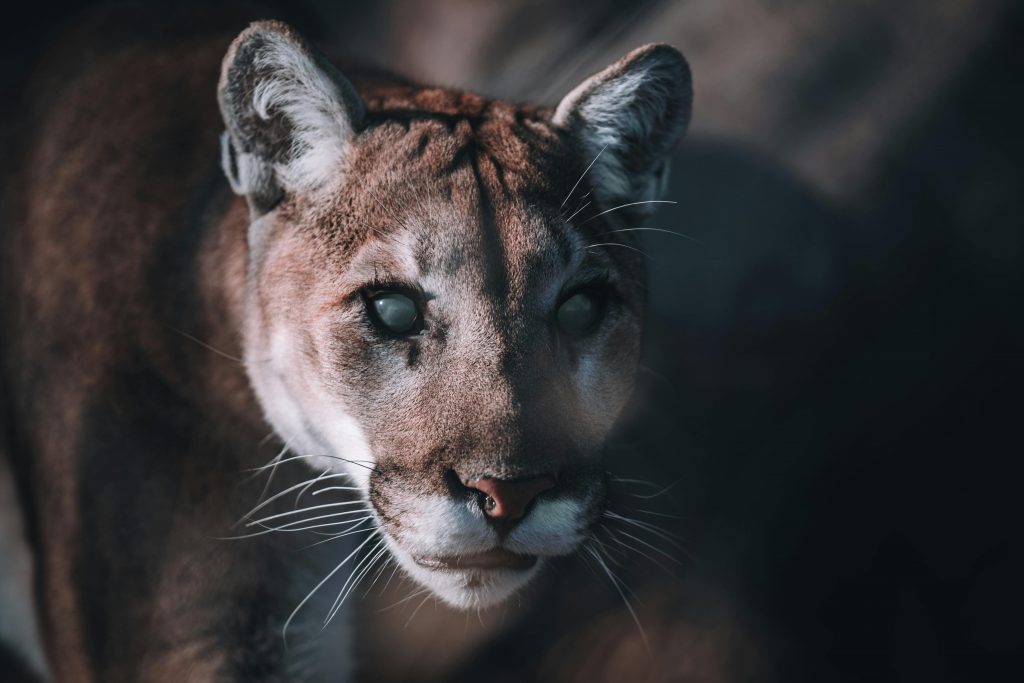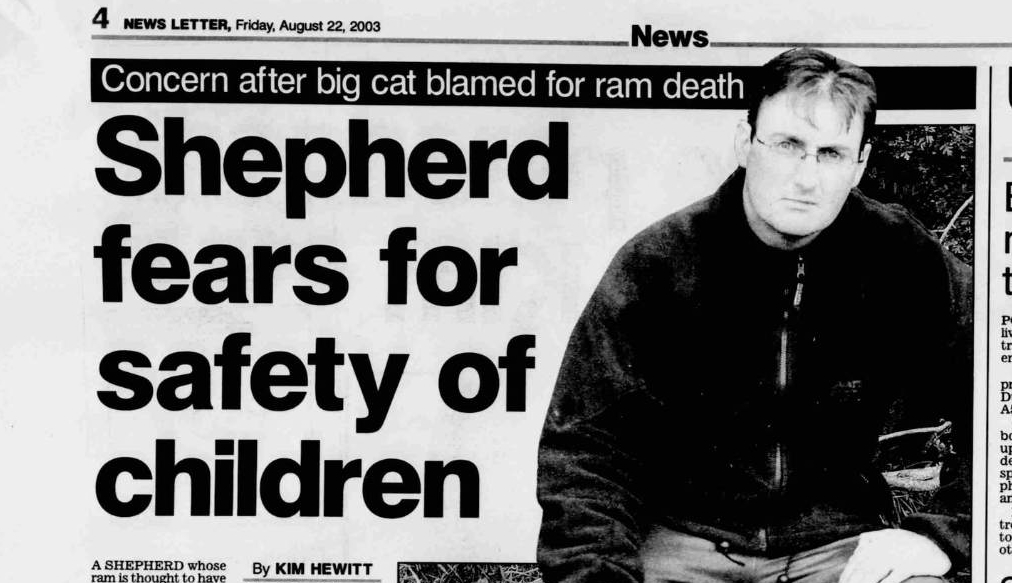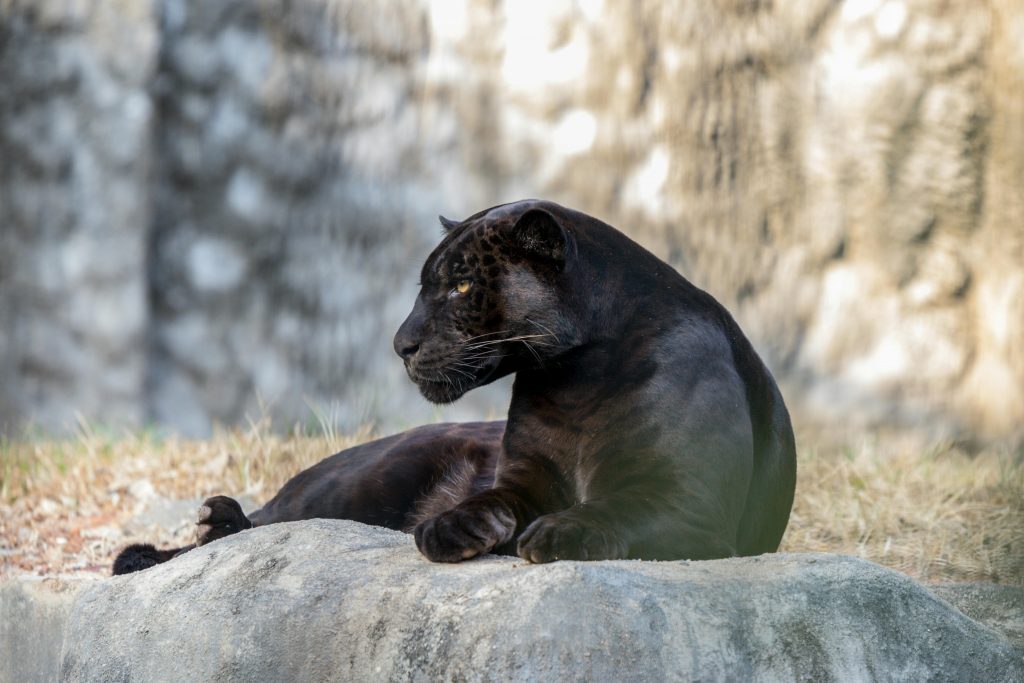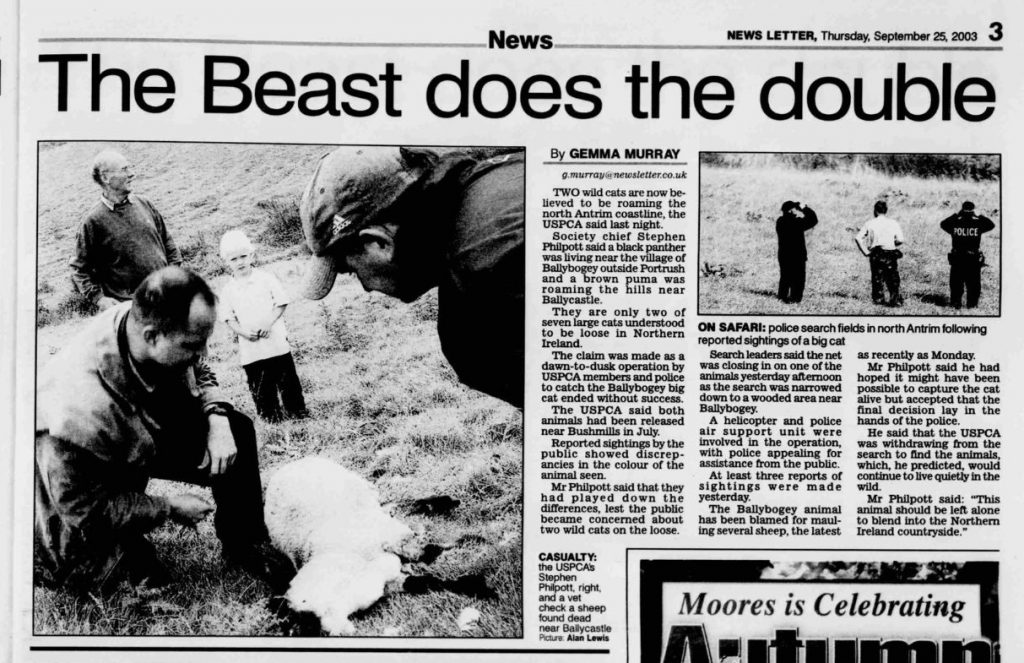
ON THE EVENING of 26 August 2003, journalist Lesley-Anne Henry had a very close encounter with the Beast of Benvarden. The Beast, which the police claimed was a puma that had been released from a “private collection”, had been savaging livestock and terrorising the good people of North Antrim since the beginning of August.
So far, it had evaded all efforts to capture it.
“Like many other reporters I have been looking for the animal so you can imagine my surprise when it ran out in front of my car on my way home from work,” Lesley-Anne said at the time. “It was about two and a half feet high and pure black in colour, with a big tail. It was only two feet in front of me. It was sylph-like and moved just like a domestic cat but it was much bigger and definitely not a dog.”
Lesley-Anne had got out of her car and tried to follow the Beast – but lost it as it entered a wooded area.
“I phoned my photographer [Sammy McMullan] who was nearby and we drove up and down the road looking for it for about 20 minutes. Then it ran back across the way it had come.
“Sammy just managed to grab his camera and got a picture of its back legs as it disappeared into the bushes.”
Sammy’s photograph, as blurry as it is, is definitely a photograph of a large, black cat. But there’s a problem with Sammy’s photograph – the only known photograph of the Beast of Benvarden. And Lesley-Anne pointed it out at the time, but without knowing the implications of her observation.
“It didn’t look how other people have described it,” she said, “so maybe I have seen something different.”
Sammy and Lesley-Anne had – without knowing it – found evidence that the police had not been telling the truth about the Beast of Benvarden.
There wasn’t one beast – there were two.
2
The Beast of Benvarden affair began on Friday, 8 August 2003 following a number of sightings of a “puma on the loose” across North Antrim. Few details were reported by the newspapers at the time, but it appears that the Police Service of Northern Ireland (PSNI) and the Ulster Society for the Prevention of Cruelty to Animals (USPCA) were so certain the sightings were genuine that they immediately launched full scale searches for the puma in Portrush, Portballintrae and Bushmills – and issued a warning to the public.
“This is a large, wild cat which may have escaped from a private collection,” said Inspector Milne Rowntree of Coleraine PSNI. “We are currently co-ordinating a search with the USPCA to locate the animal. Anyone who sights the animal in the area is advised not to approach it and to contact police in Coleraine immediately.”

The searches continued over the weekend – as did the sightings. And on Sunday, 10 August, searchers added Carrickfergus to their search area after multiple sightings of “a large black cat” in the Beltoy Road area of the town.
When searchers found a paw print in a field outside Portrush, it confirmed that some kind of large cat was stalking the North Antrim countryside.
At this stage, there was no real cause for alarm – or so it seemed. In an interview with the Coleraine Times, Inspector Rowntree said that he didn’t think the public were in any danger – and that the PSNI were working closely with the USPCA to capture the animal alive.
On 20 August, the Ballymena Weekly Telegraph published an interview with Nigel Devine, a dog warden with Ballymena Council. Nigel had been involved in the search for the Beast from the beginning, thanks to his unique position: he was the only individual in Northern Ireland with a licence to use a tranquiliser rifle.
Nigel confirmed that the police and USPCA were trying to capture the animal, not kill it, and explained that they were trying to keep the animal local to make it easier to capture.
“Turkeys have been left as bait in a four mile radius from where the cat was first spotted in the hope that it will stay in the area because there is a regular food source,” he said.
3
On Thursday, 21 August, a 70kg ram was found “savaged” on the farm of Robert Calvin, in Bushmills. The animal had large bite marks on its side – and over a kilo of meat had been torn from the body.
Calvin believed the Beast was responsible – and feared for the safety of his family.
“My biggest worry would be that I have nephews and nieces coming to the farm to see the stock and they go up the fields on their own,” he said. “If they go for a walk and come across something that is capable of doing the damage that was done to the ram, it doesn’t bear thinking about.”
Stephen Philpott, the Chief Executive of the USPCA, also believed that a large cat was behind this attack – and he shared Mr Calvin’s fears. “People are told that these are companion animals, that they are exotic pets. They are not. They are wild creatures and they will behave like that whenever they reach a certain age.”
PSNI Chief Inspector Alan Barton’s response to the attack was a little less emotive. “We cannot confirm at present this was the work of a wild cat, though it does have the hallmarks of such an attack,” he said.

The following day, Friday, 22 August, two police officers came face to face with the Beast on the Bonagher Road, between Ballymoney and Bushmills, following a call from a member of the public.
“After the officers confronted the animal this morning we put a plane up and we marked the spot in the fields where it was seen,” explained Stephen Philpott. “Then a team of trained marksmen moved into the area and started to search for it. We found a clear print which we think belongs to the animal but, apart from that, we haven’t found much more.”
Two things happened following this incident. Firstly, the focus of the search moved to the forest near the Bonagher Road, where the police officers had their sighting. And secondly, the PSNI’s Wildlife Liaison Officer, Chief Inspector Mark Mason, announced that, based on the descriptions given by the two officers, the Beast was a panther – and not a puma.
And a panther – according to the Chief Inspector – posed very little risk to the public. “Even in the wild, these animals will normally only attack the weak and the lame, he explained. “This animal has been born and bred in captivity – it’s used to being fed on dead animals, like dead birds or bits of meat.
“It is not used to killing to live, therefore it is of very low risk to us.”
The Chief Inspector’s statement appeared in the Sunday Life of 24 August. On Monday, 25 August, the Belfast News-Letter reported that, in a field near Ballycastle, another sheep had been savaged.
4

This latest attack changed everything.
On 27 August, the Coleraine Times reported that North Antrim residents were terrified and were now urging the police to track down the cat – and kill it.
In response, Chief Inspector Alan Barton said that police marksmen equipped with night vision were carrying out aerial searches of heavily wooded farmland around Portrush, Portstewart, Dervock and Bushmills – and that capturing the animal alive was no longer a priority.
“We first hoped that the cat could be captured alive,” he said. “However local people are becoming increasingly terrified that the animal will attack again. It has already killed two animals and we are therefore working on the ‘shoot to kill’ basis.
“Children as young as ten years old help on farms and farmers say that they are not prepared to take any more risks. They are also taking extra precautions with their livestock and locking them safely away in barns.”
Barton also reminded farmers of their rights, in terms of protecting their livestock. “Farmers will be aware of the rights they have in relation to any animal seen in the act of attacking or worrying livestock,” he said. In short: farmers were already authorised to shoot to kill the animal if it came near their livestock.
While they may have been experiencing terror in parts of North Antrim, it’s plausible that there were many outside of the cat’s hunting ground – and even within it – who had a hard time believing the story. It was silly season, after all, that period at the end of the summer when there’s very little “real” news for the papers to print, so they often resort to covering sensational stories to maintain sales and advertising revenue.
However, Stephen Philpott of the USPCA was certain that an actual wild cat was on the loose. “I’ve seen its tracks and I have its droppings in a police evidence bad,” he said. “I’m fully convinced we have an exotic full-grown cat on the loose. However, he’s going to be very difficult to catch.”
On Thursday, 28 August, two off-duty police officers spotted the cat in a field next to the Benvarden Road, near Ballymoney. They got out of their car and approached the animal. It turned to look at them – before taking off across a field. They tried to follow – but quickly lost the cat. During their search, however, they found a freshly savaged sheep.
What was concerning about this latest kill was that it happened just yards from Kilmoyle Primary School.
According to Ian Gregg from the Ulster Farmers’ Union, the local people were becoming increasingly worried. “People are now at the stage where they feel the joke is wearing thin,” he said. “This has been dragging on now for several weeks and people are very concerned about their families and animals. They really feel that it’s time that this thing is got.”
In the Belfast News-Letter of Saturday, 30 August, Stephen Philpott claimed that this was more likely to happen if the owner of the cat came forward. “This animal has undoubtedly come from a private collection and is the responsibility of the owner to come forward and give the USPCA or the PSNI any background information that may well lead to its capture.”
In this same article, the Belfast News-Letter refers to the cat as the “Beast of Benvarden.”
In the days that followed, the PSNI increased the number of officers involved in the hunt. They also received air support from the Royal Air Force. And these additional measures almost bore fruit – according to an article in the Belfast News-Letter of 5 September.
It seems that a surveillance team had been set up in the forest near the Benvarden Road. And after several nights of patiently waiting, they spotted the cat. But just as they were about to pounce, a car loaded with amateur photographers came roaring into a nearby field.
The cat was gone in a flash.
5
At 5:45pm on Monday, 22 September, the Henderson family encountered the Beast of Benvarden while they were driving along the Cloyden Road, between Coleraine and Bushmills.
Eight-year-old Rebecca saw it first. “I saw the big black cat,” she shouted from the back of the car.
They pulled over.
“We got out and it was just standing there in the field looking at us,” recalled Rebecca’s mother, Catherine. “It was only a short distance away from us but it wasn’t one bit troubled that we were there.”
The cat, according to the Hendersons, was dark grey with a very long tail that “curled slightly at the end.”
Catherine phoned the police. And after waiting for some time, phoned again.
Eventually they arrived. “They were armed with shotguns and I asked them would they not use tranquilisers,” said Catherine, “but they said if they were close enough to it they would shoot it.”
But the cat was long gone.
“If the police had arrived sooner after I contacted them they would have got it,” Catherine claimed at the time.
The police delay in responding to Catherine’s sighting could probably be easily explained. Resourcing issues, for example. The police were still expected to carry out their regular duties alongside the wild cat chase across North Antrim.
But their later refusal to confirm or deny the incident was strange. A PSNI spokesperson claimed that this was “in the interests of public safety.” However, other – more fleeting – sightings had been accepted without question – and officers and sharp shooters and helicopters immediately deployed on the strength of them.
Why the Hendersons’ sighting was considered problematic was never explained. Perhaps their description of the cat didn’t match that currently being reported in the media?
On 23 September, the PSNI and the USPCA announced that they would be carrying out a major operation – “from dusk to dawn” – on Wednesday, 24 September, in the Bushmills, Portrush and Ballycastle areas. In addition to a large deployment of PSNI and USPCA officers in these areas, helicopters and spotter planes would also be involved.
Additionally, the PSNI and the USPCA were asking residents in those areas to be extra vigilant and to contact Coleraine PSNI immediately if they spotted the cat.
6
Wednesday came and went. To call the “from dusk to dawn” hunt for the Beast of Benvarden a massive disappointment would be a massive understatement. Absolutely nothing of note happened that day.
It was what happened after the hunt that caused a stir.
On Thursday, 25 September, Stephen Philpott revealed that there were two wild cats on the loose: a black panther, near the village of Ballybogey, outside Portrush; and a brown puma in the hills near Ballycastle.
According to Philpott, both animals had been released near Bushmills in July.
He said that both the USPCA and the PSNI had known that there were two cats, and they had actively downplayed the discrepancies in witness descriptions to prevent the public becoming aware that there were two cats on the loose.

Having just announced that there were two wild beasts prowling around North Antrim, Philpott also announced that the USPCA were immediately withdrawing from the search for them. Both animals, he said, “should be left alone to blend into the Northern Ireland countryside.”
Philpott’s announcements were met with a mixture of bemusement and anger.
“I’m really surprised by the USPCA’s decision,” said Robert Calvin, whose ram was the first known victim of one of the cats. “They were obviously trying to protect the big cat, which I can understand, but I was hopeful they would be able to capture it.
“I sort of feel we’ve been left out on a limb. The animal is obviously a predator, and a very good predator. I fear there’s not a lot we can do about it, though I’m glad to see police have continued to take this as a serious threat.”
Joe McDonald from the Ulster Farmers’ Union said,” We certainly don’t want to see a line drawn under this because the big search this week didn’t deliver anything.”
The editor of the Belfast News-Letter also felt pretty strongly about the USPCA decision: “North Antrim is not a nature reserve for wild animals and the search must continue unabated until police and concerned civic society are satisfied that the threat from the elusive beasts is no more.”
7
A few weeks later, the people of North Antrim were still living in fear, according to David McClarty, of the Ulster Unionist Party.
“You have to live in such circumstances to fully understand the high level of fear which is gripping many people with a wild animal roaming free around the countryside,” he said. “I have talked to parents whose young children are afraid to leave home to attend school simply because they are scared of the wild cat attacking them.”
But things had grown quiet on the cat front. There had been no further killings and few reported sightings. Perhaps, like the USPCA’s Chief Executive Stephen Philpott had suggested, if left alone, the cats would just “blend into the Northern Ireland countryside.”
Perhaps.
But in early December, the “mauled carcass” of a sheep was found in a field near Ballycastle. The sheep had puncture marks on its neck and its ears “appeared to have been eaten off.” According to the Belfast Telegraph, these were the “hallmarks of a big cat attack.”
Paddy Brown, who owned the sheep, reported the incident to the USPCA’s Stephen Philpott. And while Philpott confirmed that the sheep had not been killed by a dog, a fox or a badger, he would not say if a puma or a panther had been responsible.
About a week later, on 12 December, a “slaughtered” pregnant ewe was found near Bushmills. It had “had its throat torn apart and jawbone broken.”
“Furious farmers” demanded another hunt, said the Belfast Telegraph. But there never was another hunt. In fact, it seems that those who had searched so earnestly and urgently for the Beast, had just quietly stopped looking.
8
“Could it possibly be that some at least of the big cats are insubstantial wraiths?”
Folklorists Janet & Colin Bord
It’s been 22 years since the Beast of Benvarden first prowled the North Antrim countryside. And in that time, neither of the cats supposedly responsible for the sightings has been killed or captured. And I’m not aware of any additional physical evidence – such as fur or scat – being found.
From the beginning, the PSNI and the USPCA pushed the story that the animals had been released by a “private collector” – and stuck to this story throughout. In one newspaper interview, Shephen Philpott claimed to know the identity of the dealer who sold the animals to the “private collector.”
However, neither identity was ever revealed – and no evidence to support the “private collector” story was ever produced. We only have the word of the authorities, the same authorities who admitted to deceiving the public about the true scale of the Beast of Benvarden scare.
But if the cats weren’t released by a “private collector,” how did they get here? Pumas and panthers don’t just magically appear – do they?
Maybe.
You see, the Beast of Benvarden story has been played out before – and since. The names and the places may be different, but the story – and the outcome – is essentially the same. Cat appears. Cat causes mischief. Cat disappears. A “private collector” is blamed. And little in the way of physical evidence is ever presented.
It prompted folklorists Janet & Colin Bord to consider: “Why, when intensive police searches are made, do the creatures seem able to disappear into thin air, leaving neither hair nor footprint nor dropping behind them? Could it possibly be that some at least of the big cats are insubstantial wraiths?”
Are the mystery cats really supernatural entities, like ghosts? It would explain a lot. But there’s precious little evidence for this theory, either.
Whatever they are, the cats have evaded all efforts to capture them for over two decades. And as far as I know, they are still here – somewhere.
So, if you happen to find yourself in the North Antrim countryside, please be aware: the Beasts of Benvarden could be quite near.
IOW
Recommended Reading
If you enjoyed this post and would like to know more, you might enjoy the following book:
Mystery Big Cats – by Merrily Harpur
Like I said in the article, the events in North Antrim were not unique – and have happened in other places at other times. In 2003, for example, in addition to the Beast of Benvarden sightings, there were between 2,000 and 4,000 sightings of mystery cats elsewhere across the UK and Ireland. That’s a lot of cats. And they all behaved like the Beast of Benvarden: appearing and disappearing; eating the odd sheep; evading capture and leaving very little evidence of their physical existence.
If you are interested in knowing more about these elusive felines, you should definitely read Mystery Big Cats by Merrily Harpur.
Mystery Big Cats can be found wherever you normally buy or borrow books. It’s also available on Amazon – and if you use this link, as an Amazon Associate I will receive a small commission.